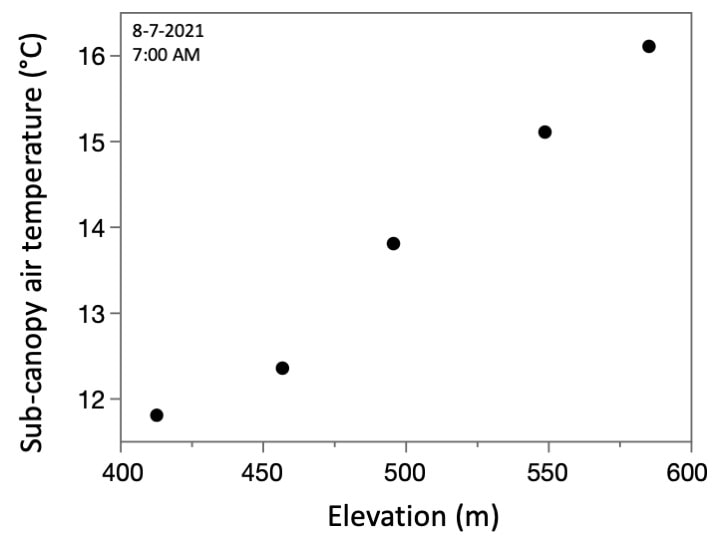Will 'microrefugia' formed by cold-air pooling preserve species and associated ecosystem functions as climate changes?
|
Landscapes with complex topography (e.g., mountains, hilly terrain) may create local cold-air pooling microclimates that are buffered and/or decoupled from regional climate change. Cold-air pooling is a globally occurring phenomenon that results in temperature inversions across elevation (i.e., lower temperatures at low relative to high elevations). This microclimatic process occurs when radiative surface cooling forms dense, cold air that drains downslope and pools in sheltered, low-lying areas like valley bottoms, sinkholes, basins, and gullies. Cold-air pooling microenvironments are often characterized by lower temperatures, higher soil moisture, lower vapor pressure deficit, a shorter frost-free season, thicker/more persistent snowpack, and less frequent and severe fires. These effects can structure plant communities by selectively favoring and/or excluding species, and can also influence plant phenology, physiology, and performance. As such, they may serve as important "microrefugia" for species that are vulnerable to climate change. I am interested in whether feedbacks between species sustained in cold-air pooling microrefugia and ecosystem properties could generate unique hotspots for carbon storage relative to areas more vulnerable to climate change impacts.
I am establishing a network of long-term monitoring transects across cold-air pooling gradients in New England forests. Each transect is composed of several plots where we inventory and measure overstory and understory forest species, measure canopy cover, sample soils and litter for carbon and other analyses, and deploy high-frequency environmental sensors. We are also measuring rates of decomposition and nitrogen availability over key temporal windows. Using the in-situ sensors, we are creating vertical sub-canopy temperature profiles spanning heights above and below the soil surface, which we will pair with free-air temperature data to explore decoupling between cold-air pooling microclimates and the free atmosphere. I have established sites in Vermont, New Hampshire, and Maine, including in Camel's Hump and Little River State Parks, the Nulhegan Basin, Second College Grant, Bartlett Experimental Forest, the Bigelow Preserve, and AMC's Maine Woods Initiative. |

Example of cold-air pooling event along a transect at Second College Grant in northern NH. The graph shows sub-canopy (1.5 m above ground) air temperatures measured via iButton sensors across 5 plots along a mountain slope. Under 'normal' conditions, we would expect temperature to decrease as elevation increases, but here, we see the opposite (i.e., a temperature inversion)! This is just one snapshot in time, but this transect experienced temperature inversions for about 50% of our continuous temperature measurements.
See: Pastore et al., 2024 Ecology and Evolution Pastore et al., 2022 Ecology Also check out these related articles: Nautilus Magazine Vermont Public Radio University of Vermont, Gund Institute News Maine EPSCoR Newsletter |

